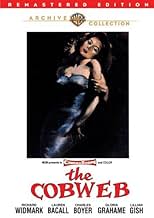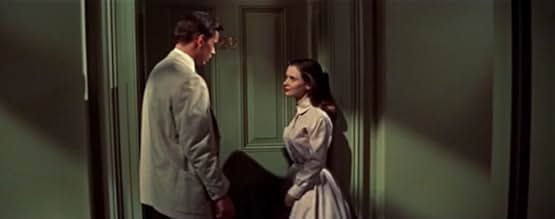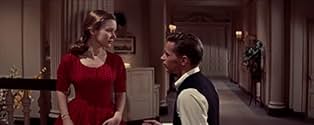At a private psychiatric clinic, the daily dramas and interactions between the doctors, nurses, administrators, benefactors and patients are accentuated by the personal and family crises of ... Read allAt a private psychiatric clinic, the daily dramas and interactions between the doctors, nurses, administrators, benefactors and patients are accentuated by the personal and family crises of these individuals.At a private psychiatric clinic, the daily dramas and interactions between the doctors, nurses, administrators, benefactors and patients are accentuated by the personal and family crises of these individuals.
Featured reviews
As I recall, the movie got promoted on the basis of its marquee cast, including the classic Lillian Gish making her first appearance in a number of years. The large number of names, of course, required the script be extended so that each star would get an appropriate amount of screen time. This results in a number of subplots and an over-stretched 2-hour-plus runtime, way more than the slender who's-going-to decide-the-draperies premise can sustain.
However, unlike most reviewers, I don't object to the running issue of the curtains, ridiculous as it sometimes seems. After all, this is an institution for troubled people including the staff, so they may well obsess over something seemingly as minor as a decoration. Then too, who makes the decision serves as a catalyst for bringing out the various unresolved conflicts among the residents. I just wish the surrounding drama was better written, acted, and directed. Certainly, the talent was there to do just that. Instead we're left with a film that remains obscure for good reason.
Richard Widmark is a new psychiatrist whose new methods allow granting of more freedom of the grounds to the inmates. What Widmark's character might think today of the number of patients walking around completely free today with only our trust that they will take their medications is interesting to speculate. Anyway it puts him at odds with Charles Boyer who is the medical head of the place.
Boyer is a man beset with problems of his own of a personal nature, he's drinking and wrenching around openly, a man going through a midlife crisis and playing it out in front of everyone including all the enemies he's made. Widmark however as a former disciple of his can't quite pull the trigger to get rid of him.
And Widmark is having his own problems, a neglected wife in Gloria Grahame and a fetching Lauren Bacall to tempt him.
But the best performance of the film comes from that grand old lady of the screen, Lillian Gish. She's the civilian record keeper of the place and a politician to the max. She plays off Widmark and Boyer, in fact The Cobweb would have been a better film had she been the central character. There's also a real good performance by Olive Carey as a Ratched like nurse, Ms. O'Brien.
John Kerr, Susan Strasberg, and Oscar Levant are all inmates of the place which is a rather posh establishment for the richer brand of neurotics. You can't imagine Widmark trying his experiments in freedom on the inhabitants of The Snake Pit.
The Cobweb is a film whose parts are greater than the whole effort. It could have been a whole lot better than it was given the talent involved.
People fret about the drapes--well really they're only the trigger for the clash. I have the strong feeling that by leaving Chicago to settle in this back-water, McIver has made a mountain of trouble for himself. His wife Karen (splendid performance by Gloria Grahame) is experiencing severe boredom and frustration; she's a sensual romantic woman who is being ignored by her husband, who is trying to find romance with Meg Rinehart (a cool Lauren Bacall). The romantic disappointments of the main characters make this film work.
It's an absorbing story of the patients and the doctors at a mental institution. Widmark has basically taken over from the troubled Boyer - though Boyer retains his title, Widmark's contract gives him more power. Bacall, a recent widow, is a doctor on staff, and Lillian Gish is an administrator. The patient most focused on is Stevie, played by John Kerr. He is making good progress with his recovery, and in fact, some of the better patients are given control over designing their lounge. The sticking point becomes the draperies which become a political football. Widmark's wife, Gloria Grahame, wants to impose herself onto the institution that is taking her husband away from her by working with a board member on the drapes; Lillian Gish wants to save money and go the cheap route; and the patients have their own ideas.
This is a very good drama with good acting from all involved. Grahame is a brunette here and has never been more beautiful, plus she gets to wear some beautiful clothes. She, along with the others, gives a terrific performance.
The one with the best role is Lillian Gish, and she is fantastic. What an actress and what a career. Who could have believed she could play such a perfect bitch? Well worth watching if the plot is a little thin.
Did you know
- TriviaMarks the return of Lillian Gish to MGM after a 22-year absence. The Cobweb was Lauren Bacall first film for MGM.
- GoofsWhen Karen (Gloria Grahame) storms into her bedroom and kicks off her shoes, she apparently launches the first one over the walls of the set, as it shoots straight up toward the supposedly low ceiling but never comes down.
- Quotes
Steven Holte: Artists are better off dead.
Karen McIver: Why?
Steven Holte: People pay more attention to them when they're dead. That's what's so troublesome.
Karen McIver: Is that what you are, a painter?
Steven Holte: They said Van Gogh was crazy because he killed himself. He couldn't sell a painting while he was alive, and now they're worth thirty million dollars. They weren't that bad then and they're not that good now, so who's crazy?
- ConnectionsFeatured in Le point de non-retour (1967)
Details
- Release date
- Country of origin
- Language
- Also known as
- La Toile de l'araignée
- Filming locations
- St. Louis Street, Lot 3, Metro-Goldwyn-Mayer Studios - 10202 W. Washington Blvd., Culver City, California, USA(McIver's neighborhood, demolished in 1972)
- Production company
- See more company credits at IMDbPro
Box office
- Budget
- $1,976,000 (estimated)
- Runtime
- 2h 14m(134 min)
- Aspect ratio
- 2.55 : 1




























